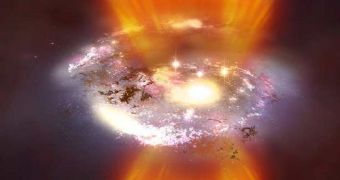Astronomers operating the Herschel Space Observatory say that they were able to use the instrument's amazing observations power to conduct an investigation of the early Universe, which revealed forming galaxies that were producing new stars at impressive rates and scales.
The new study was only made possible by the fact that the observatory, built and operated by the European Space Agency (ESA), features the largest, most sensitive mirror ever flown to space.
Herschel was launched in 2009 aboard an Ariane 5 heavy-lift delivery system, right alongside the Planck Space Telescope, whose job is to analyze the Cosmic Microwave Background (CMB) – the residual light left behind by the Big Bang.
The group of massive young galaxies that the observatory saw recently are located an estimated 11 billion light-years away, which means that we see them now as they looked just 2.76 billion years after the Big Bang, Space reports.
According to experts, the images show that these cosmic formations were caught in the midst of a so-called celestial baby boom. Each of them featured numerous areas of intense stellar formation, that were spewing out new stars at a frantic pace.
It could be that this research will provide astronomers and astrophysicists with more insight into stellar formation, and also into the way the Universe looked and behaved like when it was very young.
“These measurements have revealed the new population of galaxies to be hotter than expected, due to stars forming far much more rapidly than we previously believed,” explains Scott Chapman.
He holds an appointment as a researcher at the Institute of Astronomy in Cambridge, England, and made the announcement in a new press release.
This is not the first time that this group of old galaxies is seen. However, in optical wavelengths, observatories cannot make much sense of them, because countless clouds of dust and gas are obscuring the scene, as viewed from Earth.
Herschel is able to circumvent this issue because it operated in the far-infrared portion of the electromagnetic spectrum. This allows it to see even through the thickest dust clouds with ease.
“With the data we had before, we couldn't tell exactly where the infrared light from these galaxies comes from. […] we can [now] see that this is the signature of star formation,” says Rob Ivison.
The expert holds an appointment as an astronomy professor at the University of Edinburgh, in the United Kingdom.
“It was amazing and surprising to see the observations uncover such a dramatic population of previously unseen galaxies,” shares University of Sussex research fellow Isaac Roseboom.
Details of the amazing research are published in a special issue of the esteemed journal Monthly Notices of the Royal Astronomical Society.

 14 DAY TRIAL //
14 DAY TRIAL //